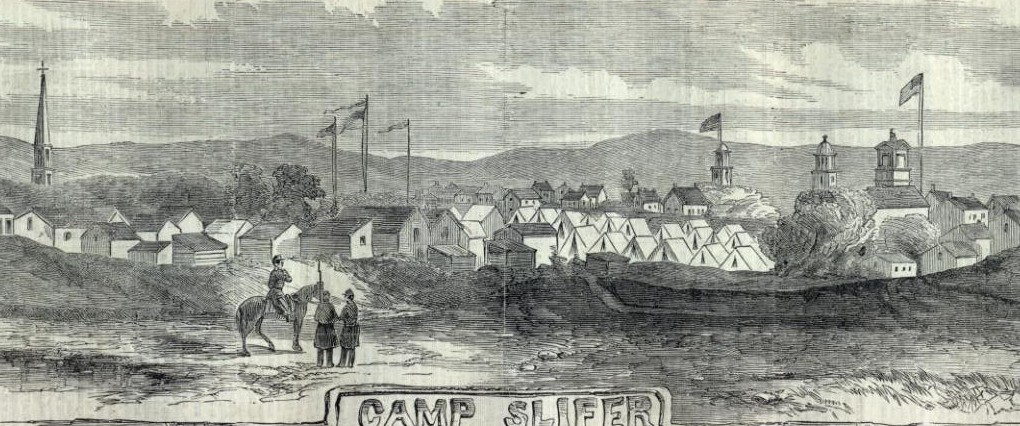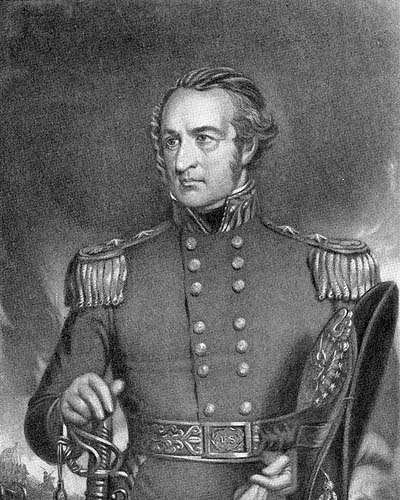Corp. John C. Gratz – 10th Pennsylvania Infantry
Posted By Norman Gasbarro on December 15, 2010
(Part 2 of 4). John Carson Gratz was born in 1843, probably in Gratz, Dauphin County, Pennsylvania, the third son of Theodore Gratz and Ann Ellen [Carson] Gratz. In 1850, John was living with his family in the large brick house on West Market Street, Gratztown. His father gave “none” as his occupation, possibly indicating that he was a “gentleman” or man of leisure. On 27 May 1855, at the age of 12, John, his older sister Caroline, and older brother Simon, were baptized at St. Stephen’s Episcopal Cathedral in Harrisburg. The baptism occurred about the time that Theodore moved his family to Harrisburg, never thereafter returning to residence in Gratztown.
A census record for 1860 has not yet been located for John, but it is believed that about this time he moved to Lykens Borough to pursue his occupation of printer. When the Civil War began in April 1861, he was one of the first to volunteer for three months duty, enlisting in Company F of the 10th Pennsylvania Infantry on 25 April 1861 and was mustered in at Camp Curtin, Harrisburg, Dauphin County, Pennsylvania. Henry Keiser of Lykens Borough was one of those who accompanied John Gratz to enlistment and service in the regiment.
By May 1, with very little training, the regiment was moved by rail from Harrisburg to Chambersburg, Pennsylvania, and thence to Camp Slifer, a training area just south of Chambersburg. The history of the 10th Pennsylvania Infantry recounts that the barrack there were comfortable, although crowded, and the men had beds of straw. Probably due to the haste of moving so many men so quickly into the camp, food rations were not available, but the farmers of the area came to the rescue by providing “wagon loads of excellent bread, meat, pies, canes and pickles, making the hearts of the soldiers glad, not more by satisfying the cravings of hunger than by the spirit of sympathy and kindness which prompted the act.”
 Camp Slifer – from Harper’s Weekly
Camp Slifer – from Harper’s Weekly
Gen. Robert Patterson was an Irish immigrant who emigrated to the United States in 1799 after his family had been banished because his father took part in an insurrection. Gen. Patterson had previously distinguished himself in both the War of 1812 and in the Mexican War. Between wars, Patterson had business interests in cotton mills and political ambitions in Philadelphia. When the Civil War began, he was called back into military service and was given command of the Pennsylvania volunteers in the Department of Pennsylvania as well as the Army of the Shenandoah. The aging Winfield Scott, General in Chief of the U.S. Armies at the beginning of the Civil War, knew and trusted Patterson and gave him the assignment to hold the main Confederate in western Virginia, well away from defenses of Washington, D.C. When Patterson didn’t act at once on the orders, his forces were outmaneuvered. The delay allowed the Confederate forces, under the command of Brig. Gen. Joseph E. Johnston, to move to provide reinforcements at the Battle of Bull Run. Criticism of Gen. Patterson mounted for his failure to contain the Confederates, and by late July 1861, Patterson’s superiors suddenly retired him with an “honorable discharge.”
 Gen. Robert Patterson (1792-1881)
Gen. Robert Patterson (1792-1881)
It was into the western Virgina campaign that Pvt. John C. Gratz was ordered along with the men of the 10th Pennsylvania Infantry Regiment. Eager to see action after what probably seemed like two months of idleness, the men were ready for a fight. Knowing that there were enemy soldiers in the area, patrols went out seeking rebel stragglers. Finding none, they returned to camp. By 24 June 1861, a bombardment began on a toll house on the Martinsburg Pike. After dislodging about 20 rebel scouts, a victory of sorts was celebrated. But the whole army, anxious for a bigger fight, proceeded into Virginia on 2 July 1861. The night before was spent in letter writing and cooking food around campfires; new uniforms arrived and the men proudly dressed in them.
From the regimental history:
Crossing the river on the 2nd, the regiment advanced by the main pike towards Martinsburg. On the line of march, the traces of war were soon visible. Large fields of wheat, which had belonged to Union men, had been destroyed by the enemy’s cavalry… A slight skirmish ensued, in which one of the enemy’s cavalry was killed and two wounded. In the afternoon the whole column marched into Martinsburg, amid demonstrations of joy and welcome from the citizens.
Gen. Patterson had orders to continue to march and do battle with the enemy. Instead, he delayed and sent a request to Gen. Scott that the army be allowed to go to Leesburg and make camp. Scott approved the base transfer on 12 Jul 1861 but wanted Patterson to wait until after the impending Battle of Bull Run, expected to be fought on 16 July 1862. Tying up the Confederates in western Virginia was a priority to Scott. On 14 July 1865, Patterson moved his men forward with each soldier carrying five days rations. On 17 July 1865 the men stopped and camped west of Charlestown but received little support from the townspeople who were strongly in favor of secession. Then on 20 July 1861, the regiment again moved toward Harper’s Ferry where a line of battle was drawn. They stayed in position until the 23rd when news was received of the crushing defeat at Bull Run. It was then that Gen. Patterson realized that Gen. Johnston had outmaneuvered him and had supplied the reinforcements that tipped the balance at the Battle of Bull Run.
The campaign was over and so was the service time of the 10th Pennsylvania Infantry. At Harper’s Ferry, Gen. Robert Patterson addressed the troops and thanked them for their loyalty and service. As he put it, he offered the enemy a fair fight and they declined. The men could now return home. “Three cheers were given for the General.”
On 24 July the regiment moved to Antietam Creek, forded the river and marched to the rail station at Hagerstown. After arrival in Harrisburg, the men were paid and mustered out of service.
For Gen. Robert Patterson, this was his last campaign. He returned to Pennsylvania and continued to pursue his business interests. But for men in the 10th Pennsylvania Infantry, most of whom had only a small taste of war, there must have been an unsettled feeling. They had not engaged the enemy and really wanted to do so. That’s probably why, within a few months, on 23 September 1861, John C. Gratz and others who had served in the 10th Pennsylvania Infantry, including Henry Keiser, enrolled at Lykens for a three year term of service. This time, he was to be in the 96th Pennsylvania Infantry as a corporal and he would be mustered in at Pottsville.
Unfortunately, Henry Keiser did not begin keeping a diary until service began in the 96th Pennsylvnaia Infantry, and we have no other primary sources for his or for John Gratz’s three-month stint in the 10th Pennsylvania Infantry. There was heavy reliance on the the official military history to write the above summary.
In tomorrow’s post, John C. Gratz and others leave Lykens and head for Pottsville, thence to service in the 96th Pennsylvania Infantry. On Friday, the final part of this series of four posts – John’s mother, Anne Ellen [Carson] Gratz, by 1864 a widow with no means of support, applies for a pension based on John’s service and is rejected.
 ;
;


It’s exceptional to read this vital post for 10th Pennsylvania Infantry…. Feel glad to learn the lifestyle of Gen. Robert Patterson….. Have a significant thanksgiving!!